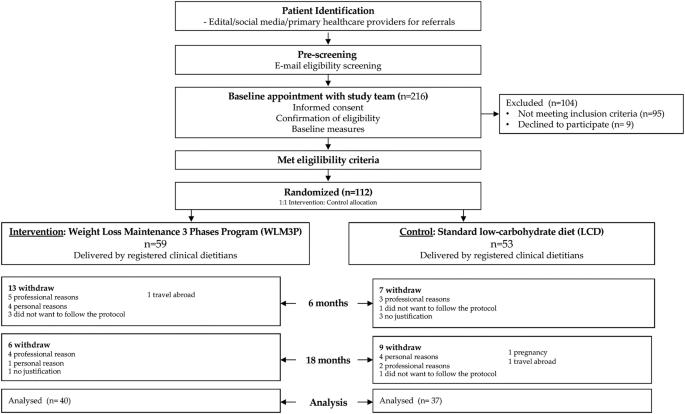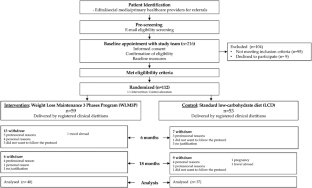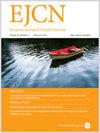成人肥胖症患者减肥维持计划随机对照试验:WLM3P 研究。
IF 3.6
3区 医学
Q2 NUTRITION & DIETETICS
引用次数: 0
摘要
背景/目标:肥胖症的流行不断升级,需要有效、可持续的减肥(WL)和体重维持策略。本研究旨在评估减重维持三阶段计划(WLM3P)与标准低碳水化合物饮食(LCD)相比,在实现肥胖症成人临床显著的长期减重(18 个月时初始减重≥5%)方面的有效性:在这项分两个阶段进行的试验中,112 名目标为初始 WL(0-6 个月)和后续维持 WL(7-18 个月)的参与者被随机分配到 WLM3P 组或 LCD 组。评估结果包括体重变化(公斤、百分比)、身体成分改善情况和代谢情况:在 112 名随机参与者中,69%(n = 77)完成了研究。18 个月后,WLM3P 组(n = 40)的 WL 值为 15.5 ± 8.3%,而 LCD 组(n = 37)的 WL 值为 9.6 ± 8.5%(p 结论:两种方案都有效促进了临床相关的 WL 值变化:两个项目都有效促进了临床相关的 WL 及其维持。然而,在经过 18 个月的干预后,WLM3P 计划在帮助参与者实现更高的 WL 目标(≥10% 和 ≥15%)以及其他临床益处方面更为成功:试验注册号:NCT04192357。本文章由计算机程序翻译,如有差异,请以英文原文为准。


A randomized controlled trial of a weight loss maintenance program in adults with obesity: the WLM3P study
The escalating obesity epidemic necessitates effective, sustainable weight loss (WL) and maintenance strategies. This study aimed to evaluate the effectiveness of the Weight Loss Maintenance 3 Phases Program (WLM3P) in achieving a clinically significant long-term weight loss (WL) (≥5% initial WL at 18 months) in adults with obesity compared to a standard low-carbohydrate diet (LCD). In this two-phase trial, 112 participants targeting initial WL (0–6 months) and subsequent maintenance (7–18 months) were randomly assigned to either WLM3P or LCD groups. Outcomes assessed included change in body weight (kg, %), improvements in body composition, and metabolic profile. Of 112 randomized participants, 69% (n = 77) completed the study. At 18 months, WL in the WLM3P group (n = 40) was 15.5 ± 8.3% compared to 9.6 ± 8.5% in the LCD group (n = 37) (p < 0.001). The odds ratio of achieving WL ≥ 10% and ≥15% were significantly higher in the WLM3P group. Complete-case analysis revealed significantly greater improvements in BMI, body fat mass, visceral fat area, waist circumference, waist-to-hip ratio, HDL, and triglyceride/HDL ratio in WLM3P than in LCD. No serious adverse events were reported. Both programs effectively promoted clinically relevant WL and its maintenance. However, the WLM3P program was more successful in helping participants achieve greater WL targets of ≥10% and ≥15%, along with other clinical benefits, after an 18-month intervention. NCT04192357.
求助全文
通过发布文献求助,成功后即可免费获取论文全文。
去求助
来源期刊
CiteScore
10.60
自引率
2.10%
发文量
189
审稿时长
3-6 weeks
期刊介绍:
The European Journal of Clinical Nutrition (EJCN) is an international, peer-reviewed journal covering all aspects of human and clinical nutrition. The journal welcomes original research, reviews, case reports and brief communications based on clinical, metabolic and epidemiological studies that describe methodologies, mechanisms, associations and benefits of nutritional interventions for clinical disease and health promotion.
Topics of interest include but are not limited to:
Nutrition and Health (including climate and ecological aspects)
Metabolism & Metabolomics
Genomics and personalized strategies in nutrition
Nutrition during the early life cycle
Health issues and nutrition in the elderly
Phenotyping in clinical nutrition
Nutrition in acute and chronic diseases
The double burden of ''malnutrition'': Under-nutrition and Obesity
Prevention of Non Communicable Diseases (NCD)

 求助内容:
求助内容: 应助结果提醒方式:
应助结果提醒方式:


